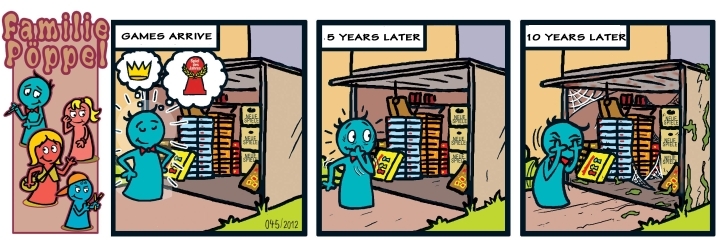Publish
After having received some refusals, game authors tend to consider if they could produce games on their own, setting up an own puslishing house. Although this surely is a possible approach, one has to think of various aspects :
- costs for an illustrator
- legal basis (CE token, regulations for games, security features, etc.)
- organizational setup (business case, VAT, EAN-Codes)
- funding (production first, selling second)
- marketing and distribution (retailer conditions, fair prices, marketing tools)
We very much wish that you do not share Paul's fate... A few general remarks and information that should help you during the first steps.
How does a game evolve ?
Here you will find a short explanation on how a game is developing: Wie entsteht ein Spiel?
Funding
Games are seen as expensive goods by the customers. In comparison to a singular event e.g. a visit at the cinema, however, a game is so much cheaper, because it can be used several times. A problem might be that usually only one player is buying a game while the other are using it for free.
Interestingly, the value of a game is often defined by its ingredients. Using many wooden components justifies a higher price, while the quality and intensity of the fun in playing is much less of relevance. In the same way, the size of a game box defines the game's value.
The consumer price basically derives from the production costs. The included materials thus defines the final price. See a typical calculation for a game that sells at a rate of 19.99 €:
| From 19,99 EUR a client pays: | ||
|---|---|---|
| Who | How much | remain |
| 19.99 EUR | ||
| State (19% taxes) | 3.19 EUR | 16.80 EUR |
| Retailer (at a net trade price of 8 €) | 8.80 EUR | 8.00 EUR |
| author (at a license fee of 6% from the net trade price) | 0.48 EUR | 7.52 EUR |
| producer | 3.76 EUR | 3.76 EUR |
| publisher | 3.76 EUR | 0.00 EUR |
Quite obviously, small improvements in the quality of the game (i.e. its ingredients) have much influence on the final price.
The high profit margin of the retailer is justified in the usually low turnover ratio. Games are also not a consumer good, but more a luxury/hobby item. Moreover, most games are not really successful. Retailers will have to sell off remaining games at low prices.
Legal aspects
- CE-sign: A MUST on all products in Europe. With putting the sign on a game, you declare that the game complies to the EU-regulation EN 71, which stands for:
- having the sign "not suitable for children under 3 years of age"
- using colors and varnish free of heavy metals
- a product that cannot injure users
In general, this is true as long as you use pieces and materials that are produced to be used in games. Producers will provide such clarifications. The CE sign itself can be downloaded in the internet.
- EAN-Code: Not really neccessary, but some retailers will see that as requirement. Can be added as label.

